MGMT 5: Marketing Fundamentals Assignment Solution - Chapter Review
VerifiedAdded on 2022/12/23
|7
|1900
|81
Homework Assignment
AI Summary
This assignment provides solutions to questions related to marketing fundamentals. It begins with an exploration of consumer behavior, detailing its stages and influence on the market. The assignment then explains market segmentation, its impact on targeting, and the role of differentiation and positioning strategies. The importance of marketing itself is discussed, along with its various orientations and the factors influencing them. Furthermore, the assignment covers marketing environmental forces, differentiating between micro and macro factors and their impact on a company's ability to serve its customers. It references various academic sources to support its claims.

Running Head: MANAGEMENT 0
MARKETING
FUNDAMENTALS
MARKETING
FUNDAMENTALS
Paraphrase This Document
Need a fresh take? Get an instant paraphrase of this document with our AI Paraphraser
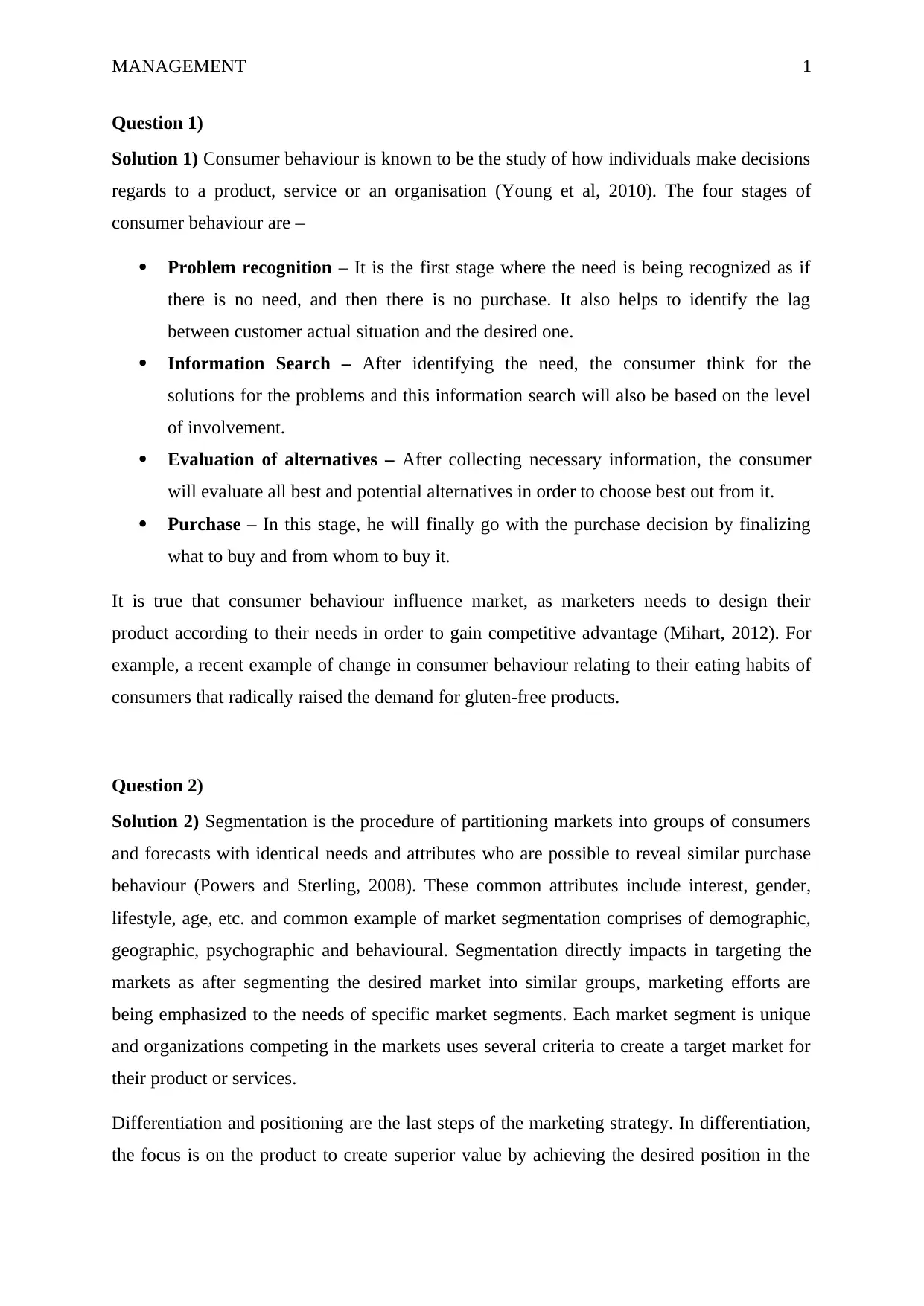
MANAGEMENT 1
Question 1)
Solution 1) Consumer behaviour is known to be the study of how individuals make decisions
regards to a product, service or an organisation (Young et al, 2010). The four stages of
consumer behaviour are –
Problem recognition – It is the first stage where the need is being recognized as if
there is no need, and then there is no purchase. It also helps to identify the lag
between customer actual situation and the desired one.
Information Search – After identifying the need, the consumer think for the
solutions for the problems and this information search will also be based on the level
of involvement.
Evaluation of alternatives – After collecting necessary information, the consumer
will evaluate all best and potential alternatives in order to choose best out from it.
Purchase – In this stage, he will finally go with the purchase decision by finalizing
what to buy and from whom to buy it.
It is true that consumer behaviour influence market, as marketers needs to design their
product according to their needs in order to gain competitive advantage (Mihart, 2012). For
example, a recent example of change in consumer behaviour relating to their eating habits of
consumers that radically raised the demand for gluten-free products.
Question 2)
Solution 2) Segmentation is the procedure of partitioning markets into groups of consumers
and forecasts with identical needs and attributes who are possible to reveal similar purchase
behaviour (Powers and Sterling, 2008). These common attributes include interest, gender,
lifestyle, age, etc. and common example of market segmentation comprises of demographic,
geographic, psychographic and behavioural. Segmentation directly impacts in targeting the
markets as after segmenting the desired market into similar groups, marketing efforts are
being emphasized to the needs of specific market segments. Each market segment is unique
and organizations competing in the markets uses several criteria to create a target market for
their product or services.
Differentiation and positioning are the last steps of the marketing strategy. In differentiation,
the focus is on the product to create superior value by achieving the desired position in the
Question 1)
Solution 1) Consumer behaviour is known to be the study of how individuals make decisions
regards to a product, service or an organisation (Young et al, 2010). The four stages of
consumer behaviour are –
Problem recognition – It is the first stage where the need is being recognized as if
there is no need, and then there is no purchase. It also helps to identify the lag
between customer actual situation and the desired one.
Information Search – After identifying the need, the consumer think for the
solutions for the problems and this information search will also be based on the level
of involvement.
Evaluation of alternatives – After collecting necessary information, the consumer
will evaluate all best and potential alternatives in order to choose best out from it.
Purchase – In this stage, he will finally go with the purchase decision by finalizing
what to buy and from whom to buy it.
It is true that consumer behaviour influence market, as marketers needs to design their
product according to their needs in order to gain competitive advantage (Mihart, 2012). For
example, a recent example of change in consumer behaviour relating to their eating habits of
consumers that radically raised the demand for gluten-free products.
Question 2)
Solution 2) Segmentation is the procedure of partitioning markets into groups of consumers
and forecasts with identical needs and attributes who are possible to reveal similar purchase
behaviour (Powers and Sterling, 2008). These common attributes include interest, gender,
lifestyle, age, etc. and common example of market segmentation comprises of demographic,
geographic, psychographic and behavioural. Segmentation directly impacts in targeting the
markets as after segmenting the desired market into similar groups, marketing efforts are
being emphasized to the needs of specific market segments. Each market segment is unique
and organizations competing in the markets uses several criteria to create a target market for
their product or services.
Differentiation and positioning are the last steps of the marketing strategy. In differentiation,
the focus is on the product to create superior value by achieving the desired position in the
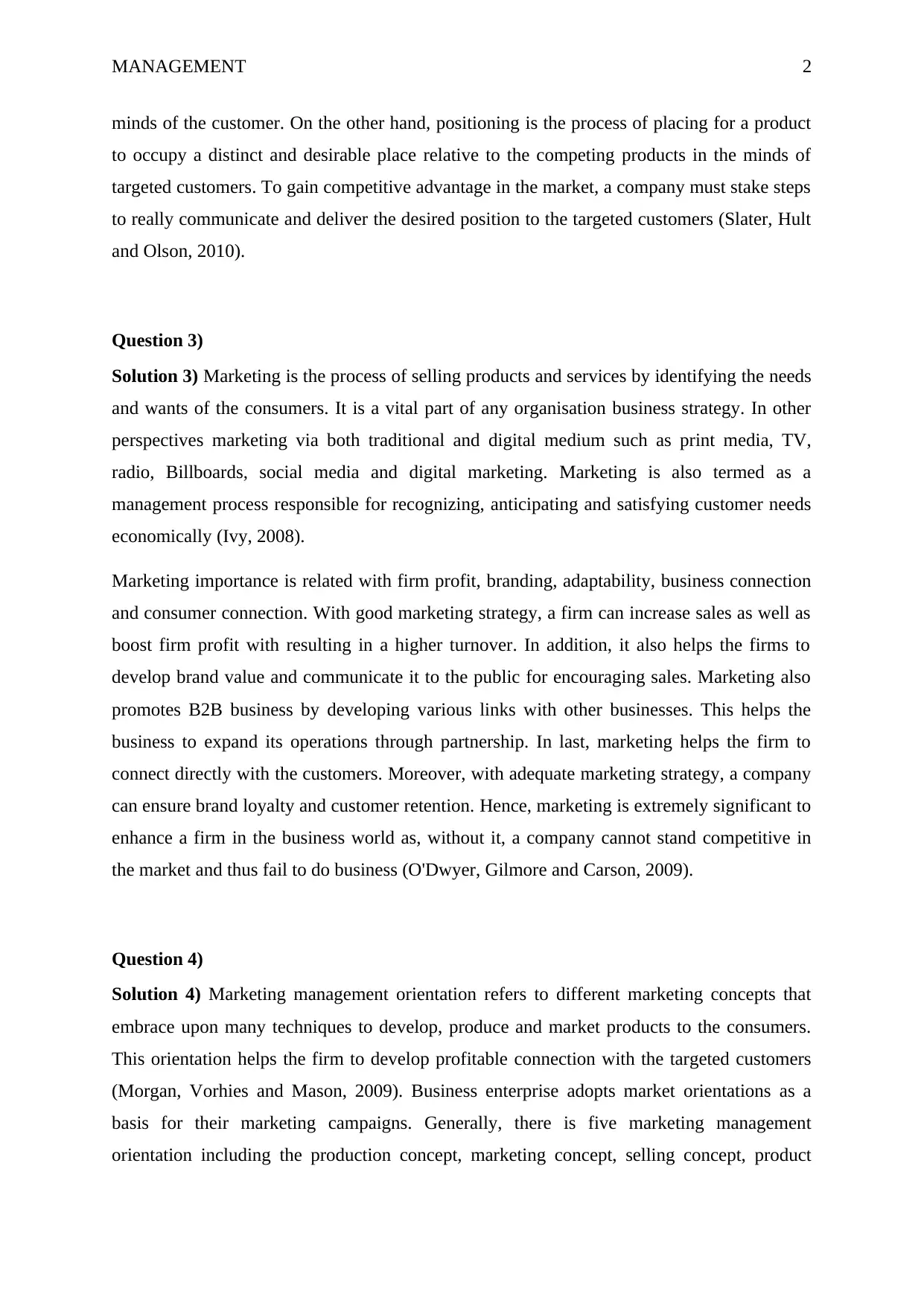
MANAGEMENT 2
minds of the customer. On the other hand, positioning is the process of placing for a product
to occupy a distinct and desirable place relative to the competing products in the minds of
targeted customers. To gain competitive advantage in the market, a company must stake steps
to really communicate and deliver the desired position to the targeted customers (Slater, Hult
and Olson, 2010).
Question 3)
Solution 3) Marketing is the process of selling products and services by identifying the needs
and wants of the consumers. It is a vital part of any organisation business strategy. In other
perspectives marketing via both traditional and digital medium such as print media, TV,
radio, Billboards, social media and digital marketing. Marketing is also termed as a
management process responsible for recognizing, anticipating and satisfying customer needs
economically (Ivy, 2008).
Marketing importance is related with firm profit, branding, adaptability, business connection
and consumer connection. With good marketing strategy, a firm can increase sales as well as
boost firm profit with resulting in a higher turnover. In addition, it also helps the firms to
develop brand value and communicate it to the public for encouraging sales. Marketing also
promotes B2B business by developing various links with other businesses. This helps the
business to expand its operations through partnership. In last, marketing helps the firm to
connect directly with the customers. Moreover, with adequate marketing strategy, a company
can ensure brand loyalty and customer retention. Hence, marketing is extremely significant to
enhance a firm in the business world as, without it, a company cannot stand competitive in
the market and thus fail to do business (O'Dwyer, Gilmore and Carson, 2009).
Question 4)
Solution 4) Marketing management orientation refers to different marketing concepts that
embrace upon many techniques to develop, produce and market products to the consumers.
This orientation helps the firm to develop profitable connection with the targeted customers
(Morgan, Vorhies and Mason, 2009). Business enterprise adopts market orientations as a
basis for their marketing campaigns. Generally, there is five marketing management
orientation including the production concept, marketing concept, selling concept, product
minds of the customer. On the other hand, positioning is the process of placing for a product
to occupy a distinct and desirable place relative to the competing products in the minds of
targeted customers. To gain competitive advantage in the market, a company must stake steps
to really communicate and deliver the desired position to the targeted customers (Slater, Hult
and Olson, 2010).
Question 3)
Solution 3) Marketing is the process of selling products and services by identifying the needs
and wants of the consumers. It is a vital part of any organisation business strategy. In other
perspectives marketing via both traditional and digital medium such as print media, TV,
radio, Billboards, social media and digital marketing. Marketing is also termed as a
management process responsible for recognizing, anticipating and satisfying customer needs
economically (Ivy, 2008).
Marketing importance is related with firm profit, branding, adaptability, business connection
and consumer connection. With good marketing strategy, a firm can increase sales as well as
boost firm profit with resulting in a higher turnover. In addition, it also helps the firms to
develop brand value and communicate it to the public for encouraging sales. Marketing also
promotes B2B business by developing various links with other businesses. This helps the
business to expand its operations through partnership. In last, marketing helps the firm to
connect directly with the customers. Moreover, with adequate marketing strategy, a company
can ensure brand loyalty and customer retention. Hence, marketing is extremely significant to
enhance a firm in the business world as, without it, a company cannot stand competitive in
the market and thus fail to do business (O'Dwyer, Gilmore and Carson, 2009).
Question 4)
Solution 4) Marketing management orientation refers to different marketing concepts that
embrace upon many techniques to develop, produce and market products to the consumers.
This orientation helps the firm to develop profitable connection with the targeted customers
(Morgan, Vorhies and Mason, 2009). Business enterprise adopts market orientations as a
basis for their marketing campaigns. Generally, there is five marketing management
orientation including the production concept, marketing concept, selling concept, product
⊘ This is a preview!⊘
Do you want full access?
Subscribe today to unlock all pages.

Trusted by 1+ million students worldwide
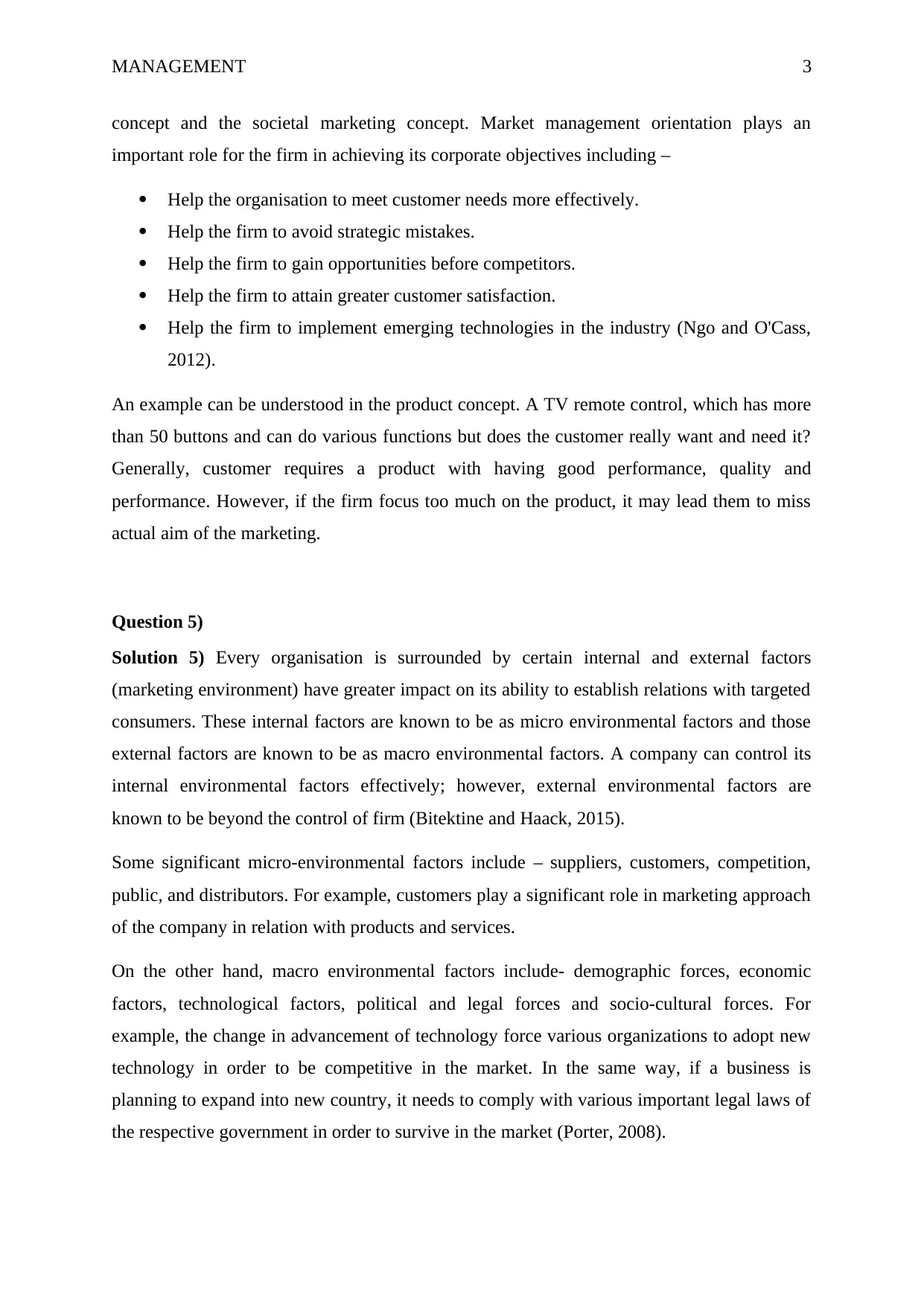
MANAGEMENT 3
concept and the societal marketing concept. Market management orientation plays an
important role for the firm in achieving its corporate objectives including –
Help the organisation to meet customer needs more effectively.
Help the firm to avoid strategic mistakes.
Help the firm to gain opportunities before competitors.
Help the firm to attain greater customer satisfaction.
Help the firm to implement emerging technologies in the industry (Ngo and O'Cass,
2012).
An example can be understood in the product concept. A TV remote control, which has more
than 50 buttons and can do various functions but does the customer really want and need it?
Generally, customer requires a product with having good performance, quality and
performance. However, if the firm focus too much on the product, it may lead them to miss
actual aim of the marketing.
Question 5)
Solution 5) Every organisation is surrounded by certain internal and external factors
(marketing environment) have greater impact on its ability to establish relations with targeted
consumers. These internal factors are known to be as micro environmental factors and those
external factors are known to be as macro environmental factors. A company can control its
internal environmental factors effectively; however, external environmental factors are
known to be beyond the control of firm (Bitektine and Haack, 2015).
Some significant micro-environmental factors include – suppliers, customers, competition,
public, and distributors. For example, customers play a significant role in marketing approach
of the company in relation with products and services.
On the other hand, macro environmental factors include- demographic forces, economic
factors, technological factors, political and legal forces and socio-cultural forces. For
example, the change in advancement of technology force various organizations to adopt new
technology in order to be competitive in the market. In the same way, if a business is
planning to expand into new country, it needs to comply with various important legal laws of
the respective government in order to survive in the market (Porter, 2008).
concept and the societal marketing concept. Market management orientation plays an
important role for the firm in achieving its corporate objectives including –
Help the organisation to meet customer needs more effectively.
Help the firm to avoid strategic mistakes.
Help the firm to gain opportunities before competitors.
Help the firm to attain greater customer satisfaction.
Help the firm to implement emerging technologies in the industry (Ngo and O'Cass,
2012).
An example can be understood in the product concept. A TV remote control, which has more
than 50 buttons and can do various functions but does the customer really want and need it?
Generally, customer requires a product with having good performance, quality and
performance. However, if the firm focus too much on the product, it may lead them to miss
actual aim of the marketing.
Question 5)
Solution 5) Every organisation is surrounded by certain internal and external factors
(marketing environment) have greater impact on its ability to establish relations with targeted
consumers. These internal factors are known to be as micro environmental factors and those
external factors are known to be as macro environmental factors. A company can control its
internal environmental factors effectively; however, external environmental factors are
known to be beyond the control of firm (Bitektine and Haack, 2015).
Some significant micro-environmental factors include – suppliers, customers, competition,
public, and distributors. For example, customers play a significant role in marketing approach
of the company in relation with products and services.
On the other hand, macro environmental factors include- demographic forces, economic
factors, technological factors, political and legal forces and socio-cultural forces. For
example, the change in advancement of technology force various organizations to adopt new
technology in order to be competitive in the market. In the same way, if a business is
planning to expand into new country, it needs to comply with various important legal laws of
the respective government in order to survive in the market (Porter, 2008).
Paraphrase This Document
Need a fresh take? Get an instant paraphrase of this document with our AI Paraphraser
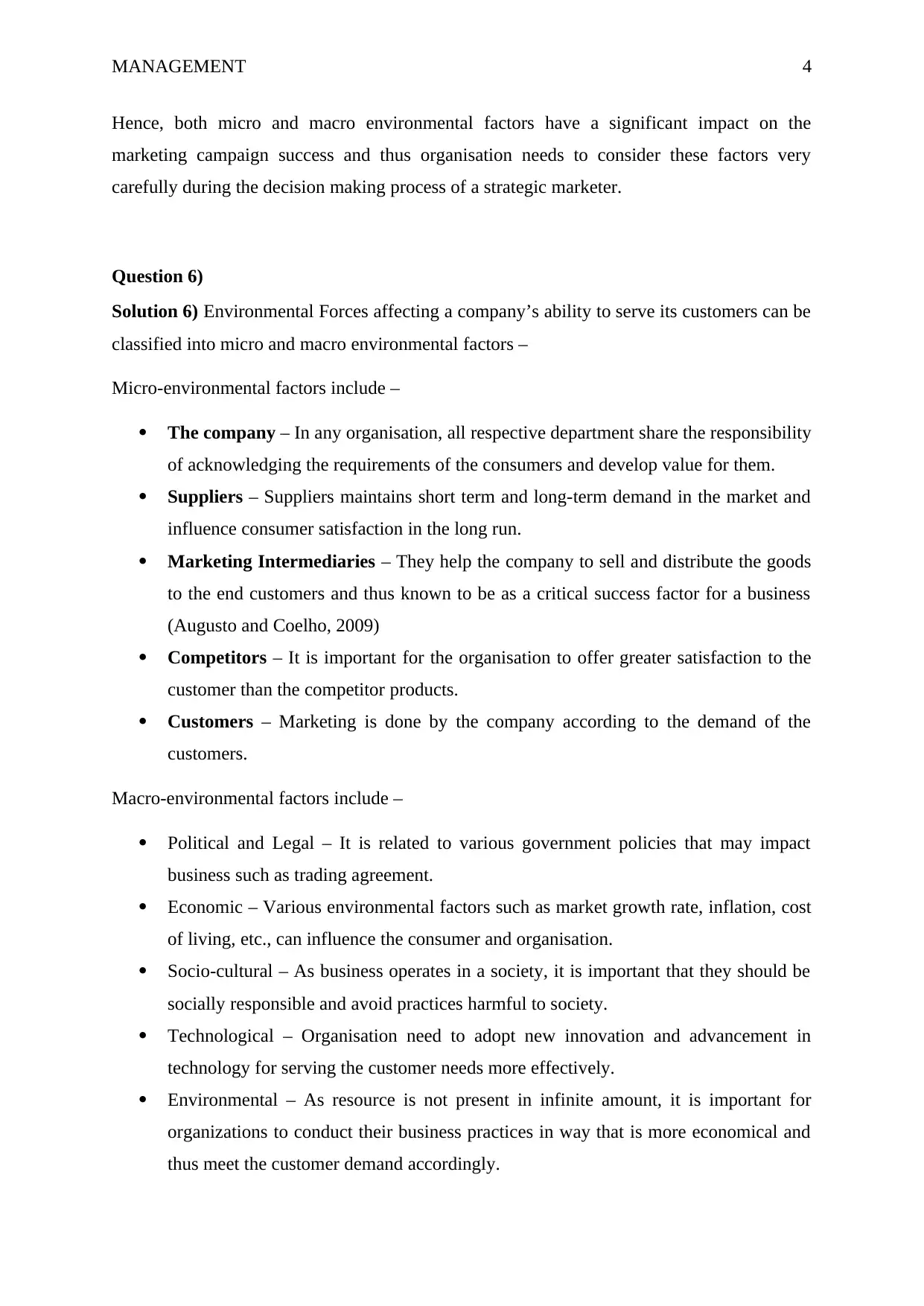
MANAGEMENT 4
Hence, both micro and macro environmental factors have a significant impact on the
marketing campaign success and thus organisation needs to consider these factors very
carefully during the decision making process of a strategic marketer.
Question 6)
Solution 6) Environmental Forces affecting a company’s ability to serve its customers can be
classified into micro and macro environmental factors –
Micro-environmental factors include –
The company – In any organisation, all respective department share the responsibility
of acknowledging the requirements of the consumers and develop value for them.
Suppliers – Suppliers maintains short term and long-term demand in the market and
influence consumer satisfaction in the long run.
Marketing Intermediaries – They help the company to sell and distribute the goods
to the end customers and thus known to be as a critical success factor for a business
(Augusto and Coelho, 2009)
Competitors – It is important for the organisation to offer greater satisfaction to the
customer than the competitor products.
Customers – Marketing is done by the company according to the demand of the
customers.
Macro-environmental factors include –
Political and Legal – It is related to various government policies that may impact
business such as trading agreement.
Economic – Various environmental factors such as market growth rate, inflation, cost
of living, etc., can influence the consumer and organisation.
Socio-cultural – As business operates in a society, it is important that they should be
socially responsible and avoid practices harmful to society.
Technological – Organisation need to adopt new innovation and advancement in
technology for serving the customer needs more effectively.
Environmental – As resource is not present in infinite amount, it is important for
organizations to conduct their business practices in way that is more economical and
thus meet the customer demand accordingly.
Hence, both micro and macro environmental factors have a significant impact on the
marketing campaign success and thus organisation needs to consider these factors very
carefully during the decision making process of a strategic marketer.
Question 6)
Solution 6) Environmental Forces affecting a company’s ability to serve its customers can be
classified into micro and macro environmental factors –
Micro-environmental factors include –
The company – In any organisation, all respective department share the responsibility
of acknowledging the requirements of the consumers and develop value for them.
Suppliers – Suppliers maintains short term and long-term demand in the market and
influence consumer satisfaction in the long run.
Marketing Intermediaries – They help the company to sell and distribute the goods
to the end customers and thus known to be as a critical success factor for a business
(Augusto and Coelho, 2009)
Competitors – It is important for the organisation to offer greater satisfaction to the
customer than the competitor products.
Customers – Marketing is done by the company according to the demand of the
customers.
Macro-environmental factors include –
Political and Legal – It is related to various government policies that may impact
business such as trading agreement.
Economic – Various environmental factors such as market growth rate, inflation, cost
of living, etc., can influence the consumer and organisation.
Socio-cultural – As business operates in a society, it is important that they should be
socially responsible and avoid practices harmful to society.
Technological – Organisation need to adopt new innovation and advancement in
technology for serving the customer needs more effectively.
Environmental – As resource is not present in infinite amount, it is important for
organizations to conduct their business practices in way that is more economical and
thus meet the customer demand accordingly.
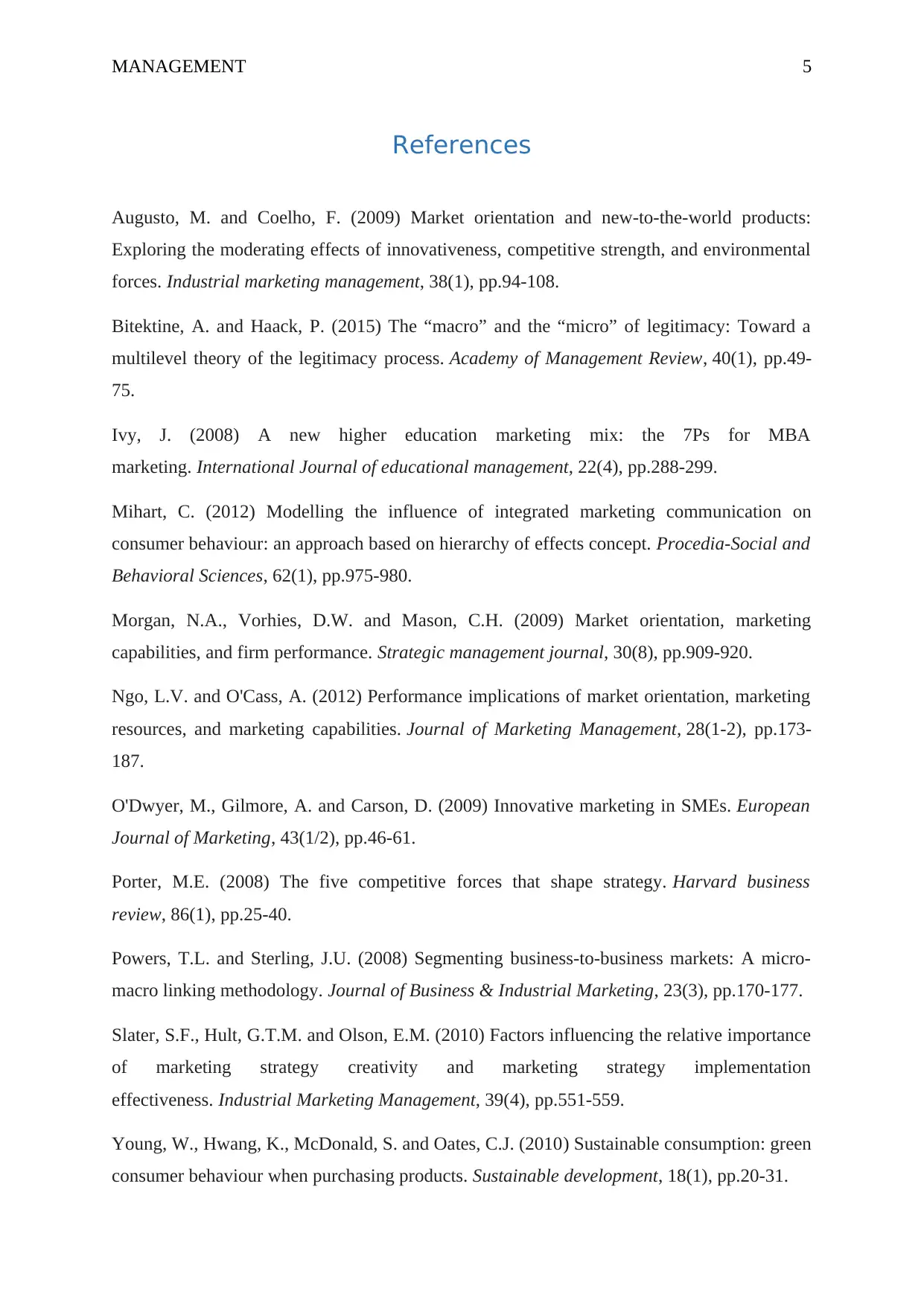
MANAGEMENT 5
References
Augusto, M. and Coelho, F. (2009) Market orientation and new-to-the-world products:
Exploring the moderating effects of innovativeness, competitive strength, and environmental
forces. Industrial marketing management, 38(1), pp.94-108.
Bitektine, A. and Haack, P. (2015) The “macro” and the “micro” of legitimacy: Toward a
multilevel theory of the legitimacy process. Academy of Management Review, 40(1), pp.49-
75.
Ivy, J. (2008) A new higher education marketing mix: the 7Ps for MBA
marketing. International Journal of educational management, 22(4), pp.288-299.
Mihart, C. (2012) Modelling the influence of integrated marketing communication on
consumer behaviour: an approach based on hierarchy of effects concept. Procedia-Social and
Behavioral Sciences, 62(1), pp.975-980.
Morgan, N.A., Vorhies, D.W. and Mason, C.H. (2009) Market orientation, marketing
capabilities, and firm performance. Strategic management journal, 30(8), pp.909-920.
Ngo, L.V. and O'Cass, A. (2012) Performance implications of market orientation, marketing
resources, and marketing capabilities. Journal of Marketing Management, 28(1-2), pp.173-
187.
O'Dwyer, M., Gilmore, A. and Carson, D. (2009) Innovative marketing in SMEs. European
Journal of Marketing, 43(1/2), pp.46-61.
Porter, M.E. (2008) The five competitive forces that shape strategy. Harvard business
review, 86(1), pp.25-40.
Powers, T.L. and Sterling, J.U. (2008) Segmenting business-to-business markets: A micro-
macro linking methodology. Journal of Business & Industrial Marketing, 23(3), pp.170-177.
Slater, S.F., Hult, G.T.M. and Olson, E.M. (2010) Factors influencing the relative importance
of marketing strategy creativity and marketing strategy implementation
effectiveness. Industrial Marketing Management, 39(4), pp.551-559.
Young, W., Hwang, K., McDonald, S. and Oates, C.J. (2010) Sustainable consumption: green
consumer behaviour when purchasing products. Sustainable development, 18(1), pp.20-31.
References
Augusto, M. and Coelho, F. (2009) Market orientation and new-to-the-world products:
Exploring the moderating effects of innovativeness, competitive strength, and environmental
forces. Industrial marketing management, 38(1), pp.94-108.
Bitektine, A. and Haack, P. (2015) The “macro” and the “micro” of legitimacy: Toward a
multilevel theory of the legitimacy process. Academy of Management Review, 40(1), pp.49-
75.
Ivy, J. (2008) A new higher education marketing mix: the 7Ps for MBA
marketing. International Journal of educational management, 22(4), pp.288-299.
Mihart, C. (2012) Modelling the influence of integrated marketing communication on
consumer behaviour: an approach based on hierarchy of effects concept. Procedia-Social and
Behavioral Sciences, 62(1), pp.975-980.
Morgan, N.A., Vorhies, D.W. and Mason, C.H. (2009) Market orientation, marketing
capabilities, and firm performance. Strategic management journal, 30(8), pp.909-920.
Ngo, L.V. and O'Cass, A. (2012) Performance implications of market orientation, marketing
resources, and marketing capabilities. Journal of Marketing Management, 28(1-2), pp.173-
187.
O'Dwyer, M., Gilmore, A. and Carson, D. (2009) Innovative marketing in SMEs. European
Journal of Marketing, 43(1/2), pp.46-61.
Porter, M.E. (2008) The five competitive forces that shape strategy. Harvard business
review, 86(1), pp.25-40.
Powers, T.L. and Sterling, J.U. (2008) Segmenting business-to-business markets: A micro-
macro linking methodology. Journal of Business & Industrial Marketing, 23(3), pp.170-177.
Slater, S.F., Hult, G.T.M. and Olson, E.M. (2010) Factors influencing the relative importance
of marketing strategy creativity and marketing strategy implementation
effectiveness. Industrial Marketing Management, 39(4), pp.551-559.
Young, W., Hwang, K., McDonald, S. and Oates, C.J. (2010) Sustainable consumption: green
consumer behaviour when purchasing products. Sustainable development, 18(1), pp.20-31.
⊘ This is a preview!⊘
Do you want full access?
Subscribe today to unlock all pages.

Trusted by 1+ million students worldwide

MANAGEMENT 6
1 out of 7
Related Documents
Your All-in-One AI-Powered Toolkit for Academic Success.
+13062052269
info@desklib.com
Available 24*7 on WhatsApp / Email
![[object Object]](/_next/static/media/star-bottom.7253800d.svg)
Unlock your academic potential
Copyright © 2020–2025 A2Z Services. All Rights Reserved. Developed and managed by ZUCOL.



